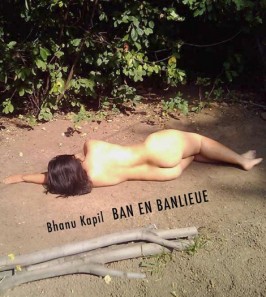
This book has two inspirations. In 1979, Blair Peach, a teacher from New Zealand, was killed by English police while protesting against a neo-fascist movement. In 2012, in Delhi, Jyoti Singh (known as Nirbhaya) was gang raped and murdered, and thrown from a bus. Drawing in part on these two deaths, and in part on her experience as the child of Indian immigrants and as a woman with brown skin, Bhanu Kapil conceived the character of Ban, a young brown girl, who hears the beginnings of a race riot, lies down on the side of a road, and gradually dissolves into her environment.
For several years, Kapil developed the idea of Ban through performance art, writing, and collaboration. This book – it can’t be called a novel – is a meditation on that process, on Ban as a character, and on the themes that link the deaths. It’s written primarily in what I suppose is prose poetry, with the occasional photograph. The book includes notes that are said to have been “rejected” (though they are included). Its tone is sometimes dream-like, sometimes brutal, never merely indicative. The acknowledgements take up around one-fifth of the total volume of the book, which was so abstract in structure that I had no idea whether the acknowledgements were actually a substantive part of it. (I skimmed them just in case.)
Did I enjoy this book? I didn’t NOT enjoy it, but let’s just say I’m glad it was short. There’s a reason I like to read novels: while I don’t object to being in the dark about some narrative elements, I have a limited amount of patience for a long piece of writing that consists entirely of a loose association of images without any obvious development, denouement, or conclusion. Still, I feel I’ve been artistically stretched and can now go back to my shallow need for traditional narrative structures in good conscience.
Trigger warnings: sexual violence; racial violence.